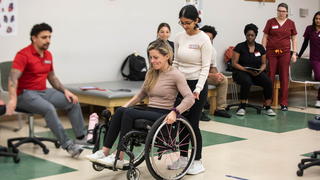Pro Bono Clinic Supports Community and Students
The University’s Samson Free Rehab has a new home, but its 20-year mission remains resolute: provide care for the community’s vulnerable populations while training the healthcare leaders of tomorrow.

After nearly two decades of serving patients at Mercy Philadelphia Hospital, Saint Joseph’s pro bono physical therapy and occupational therapy clinic, Samson Free Rehab, relocated to University City ahead of the academic year.
The clinic serves individuals with physical ailments who would otherwise be without care: the uninsured, underinsured, or those who have exhausted their insurance coverage and still need support services.
“The pro bono clinic is fantastic because it tends to serve underrepresented minorities and people who don’t have great access to healthcare,” says Margie Roos, PT, DPT, PhD, professor and chair of physical therapy. “In physical therapy, we have faculty specialists for almost everything you can think of — pediatrics, neurology, orthopedics, geriatrics — and we can treat all of those patients within our practice.”
The clinic also sees patients for a variety of occupational therapy needs, from helping individuals adapt at home or work after an injury to managing life with a chronic medical condition. It’s a harmonious blend of services that help patients live life to the fullest.
“If you have a back injury, you may see physical therapy for mobilizations, range of motion and decrease in pain, whereas you come to occupational therapy to look at workplace ergonomics, safe lifting strategies and how to manage within your day at different pain levels to complete the tasks you need and want to do,” says Wendy Walsh, PhD, OTR/L, FAOTA, clinical associate professor and chair of occupational therapy.
Samson Free Rehab not only serves the community, but it’s also a training facility for students in Saint Joseph’s School of Health Professions. The clinic employs a mentorship model in which OT and PT students learn from faculty as well as their peers.
For example, a third-year professional student in the PT program might direct a student in their first or second year to take a patient’s blood pressure reading since they’ve been honing that skill in their Cardiac Rehab course. Likewise, another student who’s been learning manual therapy techniques in the classroom might be encouraged to take over with that part of the visit.
“Students get to practice treatment and teaching, which is such a big part of what we do when we teach patients how to do exercises,” explains Roos. “After the evaluation, they talk to the faculty member and present the patient case: ‘Patient is complaining of neck pain, this is what we’re seeing, this is what we think we should do for treatment,’ and then the faculty member guides them, explains what they did well and what they could maybe do better.”
This year, the clinic has also partnered with the University’s Health Promoters Program (run out of the Institute of Clinical Bioethics) to screen vulnerable populations of patients within the area and refer them back to Samson Free Rehab for follow-up care.
“One of the core Jesuit values of St. Joe’s is service. The occupational therapy and physical therapy professions are also heavily service oriented, so we weave this into the curricula supporting the professions’ ethos,” says Walsh. “It’s such an important value and resonates so strongly with faculty that we feel honored to provide our surrounding community with these services free of charge."
